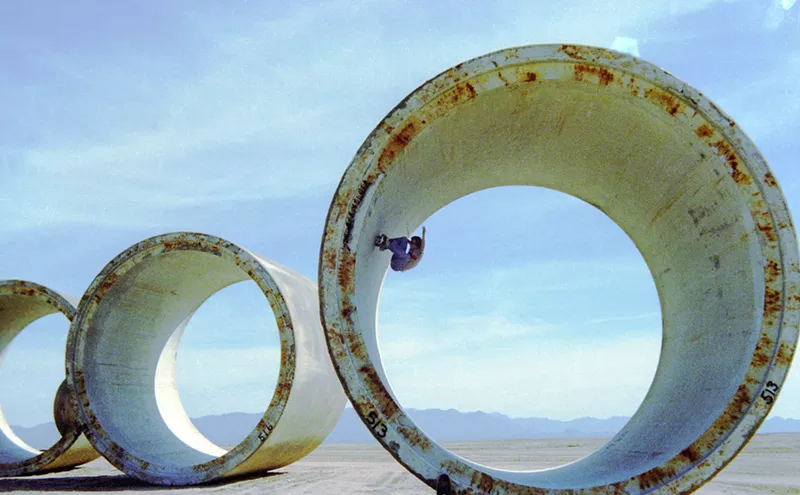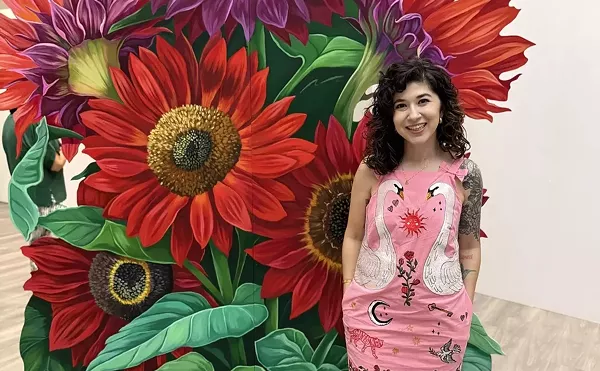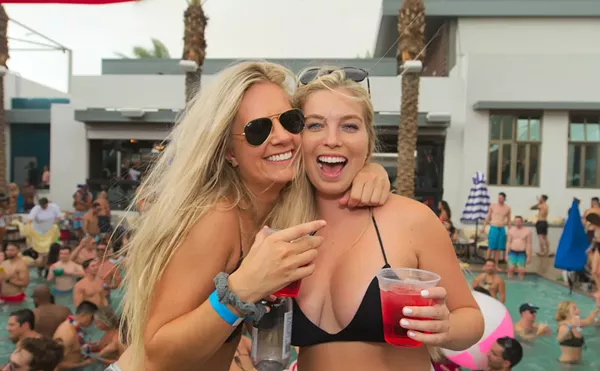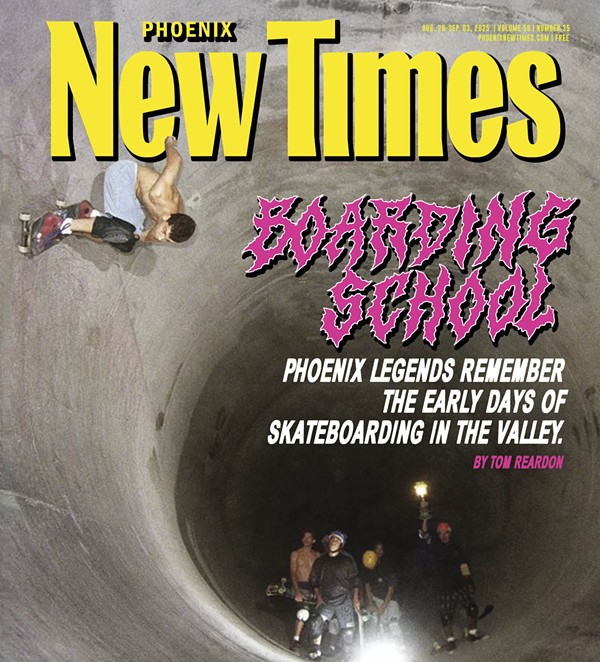Issues related to racial injustice are prevalent in contemporary political rhetoric, as both activists and creatives acknowledge that American society has yet to keep its promise of liberty and justice for all. Artists like Kara Walker, whose large-scale cut-paper silhouettes depict scenes infused with racial stereotypes, are part of the nation's cultural conversation about racial injustice. Closer to home, we've seen Ana Teresa Fernandez and the artist collective Postcommodity create works exploring injustice related to the U.S.-Mexico border. They aren't alone in their efforts.
Ongoing work by Mary Stephens, director of ASU's Performance in the Borderlands, and Leah Marche, co-founder of Black Poet Ventures, addresses multiple facets of injustice in interpersonal and community settings. In February, several local artists (including Xanthia Walker, recipient of New Times' 2015 Big Brain Award for performing arts) collaborated to present diverse stories through poetry, dance, and music in The Social Justice Project. More recently, several metro Phoenix artists participated in creating a collaborative immigration-theme mural in the Grand Avenue Arts District, and artist Elizabeth Burden showed two digital prints related to racial injustice in the 2015 Arizona Biennial.
New Times reached out to several artists whose work explores injustice related to race or ethnicity, and asked: Are Arizona artists doing enough to address issues of racial injustice? Their e-mailed responses, published below, are telling.
Julio Cesar Morales
Chief Curator, ASU Art Museum
It depends on what you consider enough? There are some Arizona artists addressing issues of inequality, but what happens when you are faced with something like say “Blue Lives Matter vs. Black Lives Matter”? Arizona is a battleground and artists should be more pissed off about the cultural environment we live in.
Leah Marche
Co-Founder, Black Poet Ventures
Nina Simone said: "An artist's duty, as far as I'm concerned, is to reflect the times.” The precursor to that statement was "You can't help it." Artists right now can't help but to address issues not just of racial injustice but injustice, period; multiple issues compound when dealing with race. Arizona artists are doing their part to "reflect the times," and the state has a number of examples of this from past to present; their passion placing them not just center stage but on the frontlines of activism. The key is making sure that artists converge with the business community and the community at large, that artists collaborate with other artists on addressing social issues as well, to bring these issues to the forefront.
Whether Ntozake Shange's for colored girls who have considered suicide/when the rainbow is enuf to Suzan-Lori Parks' The Death of the Last Black Man in the Whole Entire World or original works such as EchoVerses: Black Poets Yesterday Today. The work of BlackPoet Ventures is specifically geared to placing images on stages that illustrates notable figures in history as it relates to experiences of the African Diaspora. Freedom Summer, by Spencer Howard, is a current undertaking of Project BRAVE Performance Studio with which we are providing assistance. It addresses the events of Bloody Sunday in Selma and will be showcased during January.
Shouts out to companies like Performance in the Borderlands, Mujeres del Sol, New Carpa Theater, Shooting Columbus Ensemble, Space 55; to organizations that consistently seek out artists to communicate meaningful messages; to artists and cultural leaders like Mary Stephens, Danielle Nieto, Rashaad Thomas, Joy Young who are not afraid to speak up but to show out, and to urge people to show up; to our Arizona youth in college who participated in the Valley's youth development organization Phonetic Spit and now active in artistic campus movements that build dialogue, breed action and ultimately change.
Cristobal Martinez
Artist, Postcommodity
My reflections on this question lead me to think of additional questions and challenges for arts institutions and artists such as: What are Arizona arts institutions doing to support curatorial discourses and practices that address issues of racial injustice? What are Arizona arts institution's capacities to curate cross-cultural exhibitions, with large public outreach, that encourage respectful dialogues across race? What are Arizona arts institutions doing to mitigate identity stereotyping often occurring in exhibitions that politicize and fetishize the identities of artists of color? What are the plans by arts institutions to diversify its faculty and curatorial staff to reflect greater culturally-responsive capacities? What are arts institutions doing to make sure that artists of color can access the dialogues tied to social transformation? Do our Arizona arts institutions have the capacity to work co-intentionally with artists to organize and position art that engages the public in ways that are more meaningful, nuanced, complex, and sophisticated than the bi-partisan discourses that currently dominate media and politics?
I believe that we have effective leaders in Arizona such as our partners at the ASU Art Museum and the Scottsdale Museum of Contemporary Art, as well as Roosevelt Row, who are working very hard to productively address these questions in ways that mitigate racial injustices in Arizona and abroad. As artists, we can start by asking our supporting arts institutions and elected officials about what they are doing to address issues of racial injustices within the arts in Arizona. We can also engage in dialogues with our arts institutions and elected officials to think about how we might co-intentionally advance our art community of Arizona in ways that reflect the rich diversity of our state.
Additionally, as artists, perhaps it is productive to ask of ourselves: Is there a capacity among Arizona artists to promote cross-cultural dialogues that cut across issues without contributing to the litany of polarizing bi-partisan rhetoric? Do Arizona artists have the skills to encourage inclusive collaboration and generative knowledge creation amongst each other and within the public? Do Arizona artists have the capacity to address the complex issues that face Arizona without being didactic? Do Arizona artists possess the rhetorical skills to position metaphors within the public sphere that have the ability to promote learning and productive dialogues across diversity? My assumption regarding these skills and capacities is that we in the arts have our work cut out for us. All of these questions for arts institutions and artists are not meant to encode criticism, but to reflect on the magnitude of challenges we face in the arts, as well as to demonstrate the important role of the arts in helping to determine the nature of our world. Perhaps we can never do enough in the arts to mitigate racial injustice. Yet at the same time it is my belief that artists in Arizona model one of the most generous, supportive, productive, and inclusive communities that I have encountered in our state.
Mary Stephens
Producing Director, ASU’s Performance in the Borderlands
I think artists and cultural collectives across the state are currently, and have been, effectively addressing issues of racial and immigrant justice for a number of years. There is historical precedent for arts activism around racial justice with organizations and leaders of color as far back as M.A.R.S, Borderlands Theatre, Tucson Pima Arts Council, and as recent as Tonatierra, Cultural Coalition, Puente Ink, Shining Soul, and many more. It is only recently that we see mostly white organizations asking questions on topics of identity and race. So, I want to push back against the assumption that racial justice in the arts is something new.
The real question of racial justice in the arts should be analyzed at the level of institutional and systemic support. A true racial justice framework is more than diversity of programming, but must continually dismantle the systemic barriers that artists and leaders of color face within an exclusionary system. This is no easy task and will not fix itself with good intentions. The work of changing these systems of power demands that arts institutions address the white privilege that sustains the exclusion of people of color in leadership positions, while promoting an almost all-white arts leadership.
True change regarding racial justice in the arts in Arizona must include: reexamination of hiring practices along racial lines, paid leadership representation, bilingual leadership, professional development for white leaders to understand their white privilege, and deep understanding of the history and politics of place.
Douglas Miles
Artist
Some artists address the issue of race and others not at all. All artists have a responsibility to discuss important issues in their community at large especially in a state as ethnically and tribally diverse as Arizona. Most art here seems to be made to address the romanticism of living in the West (even Native American art) as opposed to the reality of what living in the West was really like with its history of squatters, land grabs, outlaws, brothels, cronyism, shoot-outs, political back room dealings, and territorial violence against the original inhabitants of the Grand Canyon State. Many artists do and say what they can to preserve and promote justice, most notably the street artists and muralist movement painters. Yet many artists focusing on more commercial endeavors could care less.

Audio By Carbonatix
[
{
"name": "GPT - Billboard - Slot Inline - Content - Labeled - No Desktop",
"component": "21251496",
"insertPoint": "2",
"requiredCountToDisplay": "2"
},{
"name": "STN Player - Float - Mobile Only ",
"component": "21327862",
"insertPoint": "2",
"requiredCountToDisplay": "2"
},{
"name": "Editor Picks",
"component": "16759093",
"insertPoint": "4",
"requiredCountToDisplay": "1"
},{
"name": "Inline Links",
"component": "17980324",
"insertPoint": "8th",
"startingPoint": 8,
"requiredCountToDisplay": "7",
"maxInsertions": 25
},{
"name": "GPT - 2x Rectangles Desktop, Tower on Mobile - Labeled",
"component": "21934225",
"insertPoint": "8th",
"startingPoint": 8,
"requiredCountToDisplay": "7",
"maxInsertions": 25
},{
"name": "Inline Links",
"component": "17980324",
"insertPoint": "8th",
"startingPoint": 12,
"requiredCountToDisplay": "11",
"maxInsertions": 25
},{
"name": "GPT - Leaderboard to Tower - Slot Auto-select - Labeled",
"component": "17012245",
"insertPoint": "8th",
"startingPoint": 12,
"requiredCountToDisplay": "11",
"maxInsertions": 25
}
]







